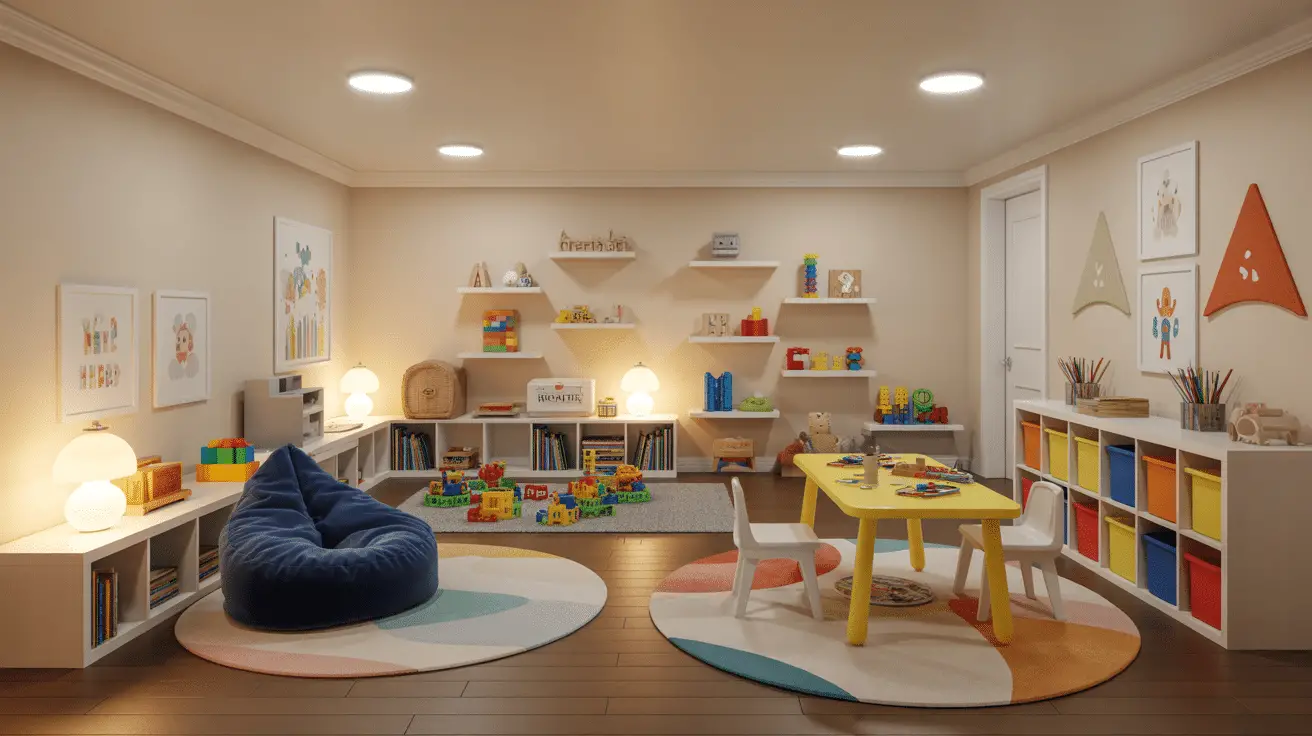Budget Friendly Basement Playroom Makeover That Shines: Creative Ideas for Stylish Family Fun
Table of Contents
Introduction
Basements often end up as the forgotten corners of the home—dim, underused, and cluttered with storage boxes. Yet, beneath those concrete walls and low ceilings lies enormous potential. With a touch of creativity and planning, a basement can become a family’s favorite destination: a cheerful, imaginative playroom that feels as bright and welcoming as any main-floor space.
According to recent home design reports, transforming underutilized basements into functional rooms has become one of the most cost-effective renovation trends. Homeowners are realizing that a basement playroom not only enhances family life but also increases overall home value. The challenge, however, is doing it beautifully—without overspending.
This article explores how to create a budget friendly basement playroom makeover that truly shines. From clever layout solutions and lighting strategies to affordable décor hacks and smart storage, you’ll learn how to maximize every square foot while keeping the design playful and cohesive. Whether you’re working with unfinished concrete or an already semi-finished basement, these practical ideas will help you craft a space your kids adore and your guests admire—all without breaking the bank.
Planning Your Basement Playroom Layout
Before diving into paint colors and decor, start with a functional layout. A well-planned basement playroom balances fun and practicality—offering zones for active play, quiet creativity, and easy cleanup. Begin by assessing your space: note ceiling height, natural light sources, and any obstructions such as support beams or ducts.
Divide the room into sections according to activity. For example, dedicate one corner for a reading nook with a bean bag and low shelving, another for building blocks or crafts, and a central open area for active play. Using rugs or foam tiles can visually define these zones without adding construction costs.
Think vertically. Basements often have limited square footage, so use wall-mounted storage, pegboards, and floating shelves to save floor space. For smaller basements, furniture that folds or stacks—like collapsible tables or toy bins on wheels—keeps the room flexible and tidy.
| Zone | Purpose | Budget-Friendly Ideas |
| Reading Nook | Quiet relaxation | Use thrifted shelves and string lights |
| Craft Corner | Creativity hub | Repurpose an old table with contact paper |
| Play Zone | Open movement | Foam mats and removable wall decals |
Brightening Up a Dim Basement
Lighting can make or break your basement playroom design. Since basements often lack natural sunlight, creating a bright and airy feel requires layering light sources strategically. Start with ambient lighting—such as recessed LED fixtures or flush-mount ceiling lights—to provide even illumination.
Next, add task lighting for play areas that need focus, like reading or crafting. Clip-on lamps, string lights, or wall sconces are affordable and easy to install. Finally, incorporate accent lighting—fairy lights around a play tent, or LED strips under shelves—to make the room sparkle with personality.
Color plays a crucial role too. Choose light, reflective wall colors like soft ivory, warm gray, or pastel blue. Gloss or satin finishes bounce light better than matte ones, creating the illusion of brightness. Mirrors and metallic decor can further enhance light reflection and depth.
| Lighting Layer | Function | Cost-Saving Tip |
| Ambient | General brightness | Use energy-efficient LED bulbs |
| Task | Focused work/play | Install inexpensive clip lights |
| Accent | Adds warmth and fun | Use string or fairy lights |
Smart Storage Solutions That Keep Chaos in Check
A beautiful playroom quickly loses its charm without organization. Smart storage is key to maintaining both style and sanity in your basement space. Look for multi-functional furniture—like benches with built-in cubbies or ottomans that double as toy chests.
Transparent bins make cleanup easier for kids while allowing you to monitor toy categories. Labeling containers with words or pictures encourages independence and helps children learn to tidy up. Vertical storage, such as hanging baskets or wall grids, keeps small items off the floor and within easy reach.
For a cohesive look, stick to one color palette or material—like natural wicker baskets, white bins, or wooden crates. This consistency brings visual calm even when toys are plentiful.
| Storage Type | Benefit | Design Tip |
| Open Shelving | Easy access | Display colorful toys neatly |
| Storage Bench | Dual purpose | Add cushions for extra seating |
| Clear Bins | Visibility | Label each bin for organization |
Creative and Affordable Wall Transformations
Walls are your canvas for creativity—and one of the easiest ways to make a budget friendly basement playroom shine. You don’t need expensive paneling or murals to create impact. Start with a coat of paint: soft pastels or bold accent walls can instantly transform the mood.
Chalkboard or dry-erase paint is another inexpensive way to add functionality and fun. Dedicate one section of the wall for doodles, learning activities, or goal tracking. Peel-and-stick wallpaper is ideal for basements—it’s moisture-resistant, removable, and comes in endless patterns to suit your theme.
For a more personal touch, frame children’s artwork or hang a rotating gallery line with clips and twine. This not only adds color but also builds your kids’ pride and ownership in the space.
| Wall Idea | Cost Level | Benefit |
| Chalkboard Paint | Low | Interactive play surface |
| Peel-and-Stick Wallpaper | Moderate | Adds pattern, removable |
| Art Display Line | Minimal | Showcases creativity |
Flooring That’s Safe, Stylish, and Affordable
Basement flooring requires both practicality and comfort, especially for active play. Carpeting may seem appealing, but moisture issues make it risky in many basements. Instead, consider modular foam mats, vinyl planks, or area rugs that can be easily cleaned or replaced.
Interlocking foam tiles are perfect for play areas—they’re soft, colorful, and shock-absorbent, providing safety for little ones. Luxury vinyl planks, meanwhile, mimic the look of hardwood while resisting moisture and wear. Layering rugs adds warmth and defines different zones in the playroom.
Don’t overlook underlayment—it can improve insulation and soundproofing, keeping your basement cozy and quiet.
| Flooring Type | Pros | Budget Tip |
| Foam Mats | Soft, safe, easy to clean | Mix colors for playful patterns |
| Vinyl Plank | Durable, moisture-resistant | Install as DIY peel-and-stick |
| Area Rugs | Adds comfort and style | Use washable or low-pile options |
Designing a Cohesive Theme Without Overspending
A unified design theme ties your playroom together. Whether you prefer whimsical, modern, or nature-inspired, consistency in color and materials makes even budget items look intentional. Start with one focal point—a patterned rug, wall mural, or main color—and build the rest of your decor around it.
Mix high and low pieces strategically. Splurge on one standout item, like a durable play table or a bold light fixture, and balance it with affordable finds from discount stores or secondhand markets. DIY crafts, such as homemade wall art or painted wooden toys, add personality without expense.
| Theme Style | Color Palette | Key Accent |
| Modern Minimal | Neutrals + pops of color | Geometric rug or wall art |
| Nature Inspired | Greens and woods | Leaf prints, wooden toys |
| Whimsical | Pastels and patterns | Play tent or mural backdrop |
Making the Space Feel Warm and Inviting
One common challenge with basement playrooms is avoiding a “cold” or unfinished feel. Warmth can be achieved through color, texture, and layering. Start with warm-toned neutrals like beige, taupe, or blush as your base, and add cozy textiles—plush rugs, soft throws, and curtains to cover small windows or divide zones.
Texture adds richness and comfort. Woven baskets, wood furniture, and fabric-covered seating create a tactile, homey vibe. Ambient lighting with warm bulbs enhances this coziness. Adding a few plants—real or faux—brings natural freshness and softens hard surfaces.
| Element | Effect | Budget Tip |
| Textiles | Adds warmth | Use old blankets or thrifted curtains |
| Wood Accents | Natural comfort | Sand and refinish old furniture |
| Plants | Liveliness | Use low-maintenance faux greenery |
Conclusion
Creating a budget friendly basement playroom that shines is all about resourcefulness, creativity, and thoughtful design. With smart planning, layered lighting, organized storage, and cohesive styling, you can transform even the darkest basement into a bright, joyful space that grows with your family.
The secret isn’t in how much you spend but in how intentionally you design. A basement playroom filled with color, comfort, and love becomes more than just a place for toys—it becomes the heart of everyday play, laughter, and lasting memories.

